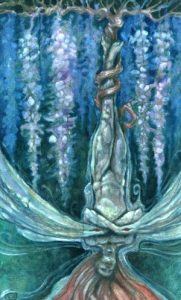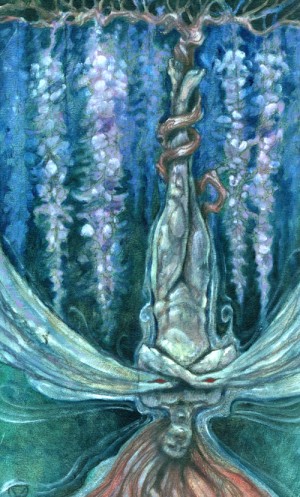
 It’s hard for me to say how much I like Marie White’s Hanged Man from the Mary-El tarot deck. When the deck was still in its infancy I made a bookmark out of the image along with a small description and laminated it, which I still have (the Star was on the reverse). The Hanged Man is a beautiful card that beautifully conveys the motionless power of powerlessness.
It’s hard for me to say how much I like Marie White’s Hanged Man from the Mary-El tarot deck. When the deck was still in its infancy I made a bookmark out of the image along with a small description and laminated it, which I still have (the Star was on the reverse). The Hanged Man is a beautiful card that beautifully conveys the motionless power of powerlessness.
Marie’s hanged person has neither breasts nor cock, and is suspended in dark liquid by thick, ropy roots that run along the top of the card (perhaps the roots of the tree we’re accustomed to seeing the man hung from in more traditional decks). The body of the figure is superficially human, but in White’s customary dreamlike transformation the hands of figure have become the diaphanous wings of an insect, scintillating with the crystalline purples and greens. The fleshy stalks where human hands might once have been are marked by two deep red wounds, reminders of the hanged man’s holy kin, martyred on the cross and on the tree.
It’s strange that until today I’ve never made the connection between Christ and the butterfly. It’s an obvious one now that it’s dawned on me, the suspension from the tree and the radical transformation that takes place during the time of suspension, both the martyr and the caterpillar reborn. The earthbound creatures take flight, no longer subject to the whims of gravity, but free to take to the sky.
The nature of this transformation brings me back once again to the multifaceted lessons of the Hanged Man. I wrote originally about this card, “Without intention to transcend the physical discomfort of his situation the Hanged Man is merely a victim, at the mercy of the world around him, in no way responsible for the situation he finds himself in, able to blame the people around him for putting him in this place. Christ, Buddha and Odin have no one to blame for their lots but themselves. Can we do any less?” My point is that in order to unlock the chief lesson of this card we must learn to take responsibility for the situations we find ourselves in rather than simply grumble about the cruelty of the world that would do this to us.
What’s fascinating about the implications of Marie’s vision of the hanged man is the way it implies this situation is an organic and inevitable transformation, a part of our life cycle, no more avoidable than adolescence (another apt metaphor for this card, or perhaps the reverse) or death. Superficially this idea seems to contradict the idea of intention; essentially that we choose our moments of sacrifice. In digging deeper, I don’t believe that’s there’s any contradiction at all. Moments of powerlessness are inevitable in our lives. As the saying goes, “Change is inevitable, growth is intentional”. These moments when we find ourselves powerless are ways that we can transform ourselves with intention or perhaps simply be changed and continue to complain about it. Becoming a butterfly would a huge inconvenience to remaining a caterpillar.
Transformation isn’t easy. To say it’s an inconvenience is an incredible understatement. When caterpillars become butterflies they literally melt themselves down and build themselves into something completely new. Their whole body dissolves and nearly everything that they were disappears to make space, material and energy for what they are about to become. The humming energy of that transformation symbolized in Marie’s card by the steaming columns of bubbles rising from the figure and its wings, in the curls of steam rising up from its elbows and shoulders. Deep within the subconscious (symbolized as always by a body of water) our identity is undergoing a massive transformation, dissolving in order to rebuild itself in a completely new way, with eyes to see beyond mortal forms, ears to hear voices without mouths.
In many ways this card is a microcosm of spirit of the savior, a look inside the psycho-spiritual transformation that we must undergo to transform ourselves from victims into heroes. No longer representing simply the external forms, Marie has pushed past the skin and bones, into the dream world of identity and experience, traded the brain for the mind and created a dreamscape where there is no delineation between symbol and figure. Inside the mind of the martyr is where the transformation occurs, outside the subtle glow of the halo is the only evidence of this process.
Looking past the transformation, it is no surprise that Death follows the Hanged Man. Once the internal transformation is complete and we find our way down from the tree, the life we once lived is gone. The people we knew do not recognize us and the patterns and habits that formed a deep part of who we were and how we walked in the world no longer fit us. The momentum that carried our previous identity forward has dissipated and it begins to fall apart, a body without a spirit gripped by the decaying hand of inertia. Desiccated and dry, we no longer have any use for what once contained us. We have left it behind and are ready to move on to a new life in the sky on the wings of a butterfly.